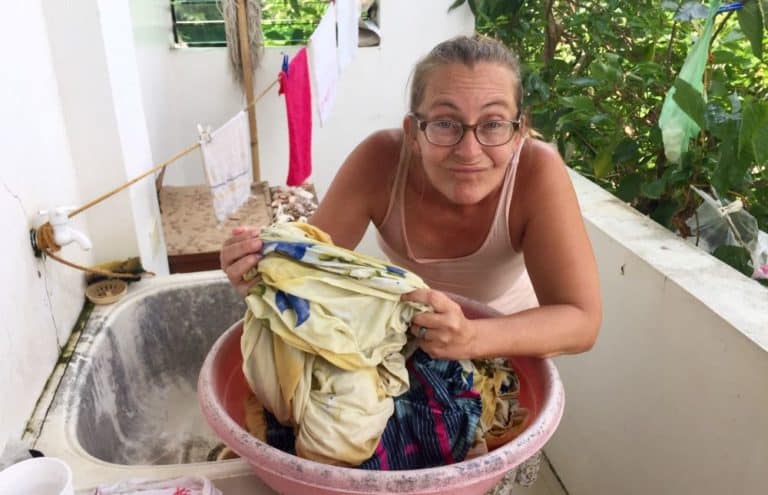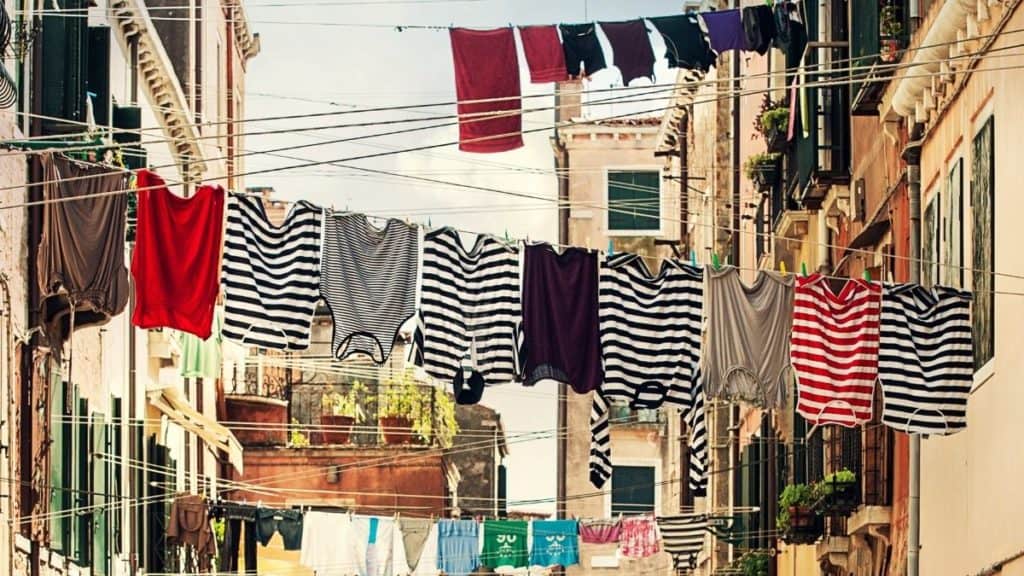This post on how to hand wash clothes and sheets has been “in the can” since April 2020. That’s a term we used in the news business for a story that is finished, but hasn’t run yet. I just never published it. I wrote it to help a friend, but I ended up simply explaining it to her and eventually forgot about this post.
Until recently.
I’ve hand washed our clothing around the world. Usually for short stints if we’re in a hotel or on the move. When we set up base for a slow travel stop at a month-long rental, we will bring the laundry to a laundromat if the rental doesn’t have a washer.
In the beginning of our slow travel pause, which started on March 16, 2020, I began hand washing everything – clothes, sheets, shower towels, hand towels, kitchen towels. Big towels are the toughest – they’re heavy and thick. But my labor was a money saver.
For nearly 22 months I hand washed all our stuff.
A few weeks ago I lifted a bucket of dirty water without bending my knees, and I strained my back. Bad. Real bad. A sign of getting older, I guess. It still bugs me a bit.
Guess what? I’m not doing hand washing most of our stuff anymore. Nearly two years is enough.
I realize there are people in this world — including around us every day — who have hand washed things all their lives and will continue to do that until the day they die. Some people I know must haul it all to the river — they don’t have running water service in their nipa huts.
Believe me, I realize I’m lucky to have $5 to take our clothes and sheets and towels to the laundry service a mile away.
I say that now, but it’s always possible something could happen to make me eat those words and force me to do it again.
Something like… a pandemic! Ha!
Anyway, read on my western friends in developed nations – on how to wash sheets, towels, clothes.

(The following post was written in April 2020, and never published.)
How to hand wash clothes and sheets
A friend of mine lamented all the laundromats near her apartment in New York City are closed because of the coronavirus, and she can’t seem to get the hang of how to wash clothes — especially sheets — without machines. So today I want to share what I’ve learned since traveling the world in places where women still do their own laundry.
I know a lot of urbanites who might be just as lost on how to hand wash clothes and sheets in a pandemic. Towels, too. And so, this handy guide is for those people who want to hand wash their stuff, but are too embarrassed to ask.
It’s not rocket science. But it’s not exactly easy when you are used to dropping off your laundry to a service or if you normally toss it into machines.
Basic steps: spot treat, soak, wash/soak, rinse, wring, rinse again, wring again, hang to dry.
Soap
Spot treat soiled items with soap and little water, rubbing soap into fabric.
In developing nations, soap often is sold with fabric softener added to powder, and I recommend this if you can buy it. It will be easier on your hands.
Also, laundry bars of soap are literally bars of laundry detergent. I cannot recall ever seeing them sold in America, but one is pictured below. These are helpful, if you can find one. If not, any laundry soap is fine.
If you have something really soiled, you feel free to add a spot of bleach into the soapy water – but not too much or your cloth will suffer stiffness and possible discoloration.
Soak – in soapy water
Where? Either a bathtub or a large plastic bin designed to wash clothing. These are common in developing countries and an example is pictured below. Or, you could use a large utility sink, or a kitchen sink.
How much soap? Most large containers will have instructions for hand washing. Go by that.
How long? This will depend on what you are washing, how dirty it is, and what your set up is like. A video by the Today Show on YouTube is helpful to get your bearings and you can see how simple soaking can really work! Take a minute to watch it. It will help you. Then come back here.
Wash, part 2
If part one is the soaking, part two of the wash will be the “stirring” you saw in that video. Or, put your hands on the items in the soapy water, and shake it. Hard. Rub it against itself. Get all the gunk stuck in the fabric out! Now’s the time after it’s softened up from soaking. Think about what your washer does: your soaked items move back and forth, back and forth.
I don’t soak some items as long as was shown in that video. How long you soak, and wash, is up to your judgement.
If the clothing is super soiled, I might soak again, in another batch of fresh water with new soap and then scrub-a-dub-dub.
How to wring washed items
One trick to cleaner items with less work: how well you wring the items.
I find this to be the most difficult part in how to hand wash clothes and sheets, and especially heavy towels.
If you have weaker hands and wrists, this will be tough. Grab the items like you were giving someone a rope burn on the arm — twist! The more liquid you get out now, the less you’ll have to do later.
Wringing is the hardest part.
Take breaks. Stretch your hands and wrists. Do the laundry on a day you feel strong. Seriously.
Rinse, wring, again…
Clean water in the tub, bin, or sink, and wrung items go in – one at a time – and shake them with your hand. The water will be somewhat bubbly, and somewhat gray – but not as gray as the first soak water.
Wring the stuff as best you can again. Take breaks, enlist help, stretch your arms, shake your hands.
The second clear water rinse should stay clear. If it starts having a few ‘bubbles’ but the water is still clear, simply change the water. Since you are rinsing and shaking one thing at a time, you might get four or five items through the second rinse before you need a water change. (By the way: you need just a half a bin of water for rinses. A little water actually goes a long way.)
On the final wring, you want this to be the best it can be, because the next step is to dry. If you have trouble wringing items, try the blot method. Use a clean towel to absorb water from your garments or sheets.
This trick creates more work in one way: now you have a towel to dry and that could be a hindrance if you have limited space. In a New York City apartment. In April. In a pandemic.
A Turkish towel is my preference for the blot method, because those are more absorbent and they dry faster than a normal towel. But I don’t need it in the tropical sun. Lucky me.
*And thick, heavy bath towels are the hardest to wash, and to dry. A pain in the ass, really.
How to dry
Ideally, a roof in the sun with laundry lines and lots of clothes pins is an option for you.
Wherever possible, use sunlight or a fan. If you can’t use either, your items might take two days to dry, especially towels, so plan accordingly. Use clothes pins can secure several smaller items (socks, underwear) onto a hangar if you have limited space.
Here are some solutions I’ve used when it was raining, or when I had to dry something fast overnight because of our travel schedule.
- hook hangars on curtain rods
- put hangars of clothes on towel racks
- hook hangars on open dresser drawers
- drape wet clothing over a hard chair (not wood!)
- drape sheets over the backs of several chairs
You can do it. It’s time consuming, mind numbing, work. But it’s not difficult.
Thanks for reading, “How to hand wash clothes and sheets.”
You might also like:
- Unusual, top 10 handy items on our pack list
- How to snorkel the easy, cheap way
- 3 travel hacks for renting during ‘shoulder season’
Ellen and Tedly alternate days of posting to the blog during the Enhanced Community Quarantine in the Philippines. They advocate for travel when lockdowns are lifted and borders are open.
(End of the April 2020 post.)

